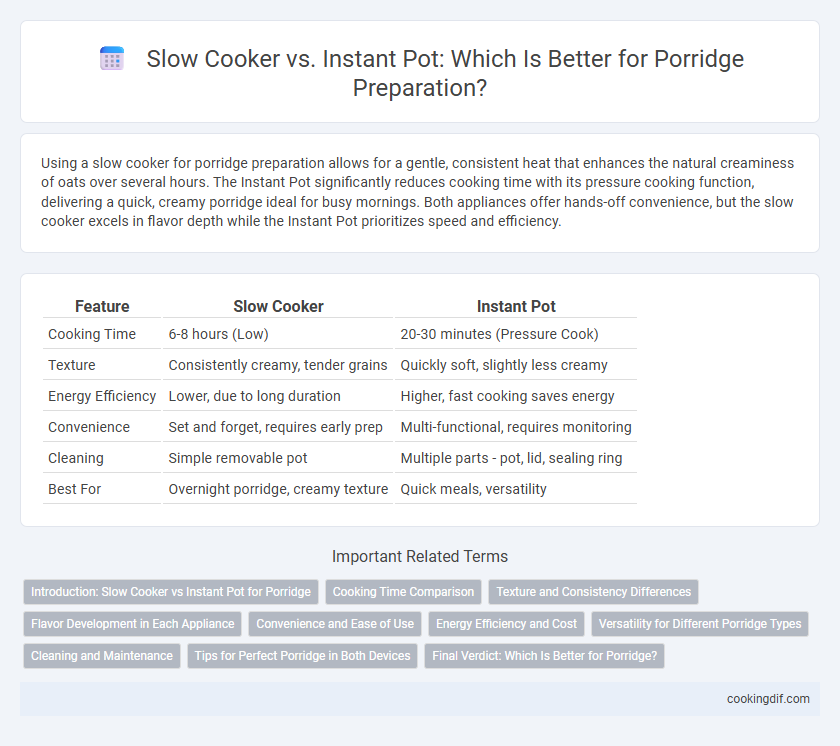Using a slow cooker for porridge preparation allows for a gentle, consistent heat that enhances the natural creaminess of oats over several hours. The Instant Pot significantly reduces cooking time with its pressure cooking function, delivering a quick, creamy porridge ideal for busy mornings. Both appliances offer hands-off convenience, but the slow cooker excels in flavor depth while the Instant Pot prioritizes speed and efficiency.
Table of Comparison
| Feature | Slow Cooker | Instant Pot |
|---|---|---|
| Cooking Time | 6-8 hours (Low) | 20-30 minutes (Pressure Cook) |
| Texture | Consistently creamy, tender grains | Quickly soft, slightly less creamy |
| Energy Efficiency | Lower, due to long duration | Higher, fast cooking saves energy |
| Convenience | Set and forget, requires early prep | Multi-functional, requires monitoring |
| Cleaning | Simple removable pot | Multiple parts - pot, lid, sealing ring |
| Best For | Overnight porridge, creamy texture | Quick meals, versatility |
Introduction: Slow Cooker vs Instant Pot for Porridge
Slow cookers provide a gentle, low-temperature environment ideal for consistently creamy porridge, allowing grains to absorb liquid gradually over several hours. Instant Pots offer rapid pressure cooking, reducing porridge preparation time significantly while retaining nutrients and flavor. Choosing between the two depends on preferred cooking duration and desired texture precision in porridge preparation.
Cooking Time Comparison
Slow cookers typically require 4 to 6 hours to prepare porridge, allowing grains to soften gradually and develop a rich, creamy texture. Instant Pots significantly reduce cooking time to about 10 to 15 minutes under pressure, making them ideal for quick meals without sacrificing consistency. The Instant Pot's pressure cooking technology accelerates starch gelatinization, while slow cookers emphasize low, steady heat for enhanced flavor infusion.
Texture and Consistency Differences
Slow cookers create porridge with a creamier, more uniform texture due to low and consistent heat over several hours, allowing grains to fully absorb liquid without breaking apart. Instant pots, using high pressure and shorter cooking time, produce a porridge that is thicker and slightly chunkier, with a more pronounced grain texture. Adjusting liquid ratios in either method is crucial for achieving desired consistency, where slow cookers lean toward smoother results and instant pots offer a hearty, robust porridge.
Flavor Development in Each Appliance
Slow cookers enhance porridge flavor through prolonged, gentle heat that allows grains to fully absorb liquids and release natural sweetness, resulting in a rich, creamy texture. Instant Pots accelerate flavor development by using high-pressure cooking, which intensifies taste compounds quickly but may yield a slightly less nuanced profile compared to slow simmering. Choosing between these appliances depends on whether deeper, slowly developed flavors or rapid, intensified taste is preferred in porridge preparation.
Convenience and Ease of Use
A slow cooker offers hands-off cooking with minimal monitoring, allowing porridge to cook gently over several hours for a creamy texture, ideal for busy mornings. The Instant Pot significantly reduces cooking time with programmable settings, enabling quick preparation and easy cleanup without sacrificing flavor or consistency. Both appliances provide convenient options, but the Instant Pot excels in speed and multifunctionality, while the slow cooker ensures simplicity and a more traditional slow-cooked taste.
Energy Efficiency and Cost
Slow cookers consume less electricity over extended cooking periods, making them more energy-efficient for porridge recipes that require slow simmering. Instant Pots use higher wattage but reduce overall cooking time, potentially lowering electricity costs depending on usage frequency. Cost-wise, slow cookers generally have lower upfront prices, while Instant Pots offer multifunctionality that may offset the initial investment in the long term.
Versatility for Different Porridge Types
Slow cookers offer consistent low heat ideal for traditional steel-cut oats and rice porridges, allowing grains to absorb liquid evenly for a creamy texture. Instant Pots provide versatile cooking modes, including pressure cooking and sauteing, which accommodate a wider range of porridge types such as multigrain, quinoa, and bean-based porridges with faster cooking times. The Instant Pot's ability to switch between settings enhances experimentation with texture and ingredients, making it more adaptable for diverse porridge recipes.
Cleaning and Maintenance
Slow cookers have simple components such as a removable ceramic insert and a lid, making cleaning straightforward and gentle on materials. Instant Pots contain multiple parts, including a sealing ring, inner pot, and steam release valve, which require detailed cleaning and periodic replacement to maintain performance. Both appliances benefit from dishwasher-safe inserts, but instant pots demand more regular maintenance to prevent residue buildup and ensure safety during pressure cooking.
Tips for Perfect Porridge in Both Devices
For perfect porridge in a slow cooker, use a ratio of 1 part oats to 4 parts liquid and cook on low for 6-8 hours to achieve creamy texture. In an Instant Pot, combine oats and liquid with a pinch of salt, select the porridge setting or cook on high pressure for 3-5 minutes, then allow natural pressure release to avoid overcooking. Stir well after cooking, and add fruits, nuts, or sweeteners to enhance flavor and texture in both devices.
Final Verdict: Which Is Better for Porridge?
The Instant Pot excels in porridge preparation by significantly reducing cooking time while maintaining creamy texture through precise pressure control. Slow cookers offer convenience for overnight cooking but may result in less consistent texture due to longer, low-temperature cooking. For optimal porridge quality with time efficiency, the Instant Pot is the superior choice.
Slow cooker vs instant pot for porridge preparation Infographic

 cookingdif.com
cookingdif.com